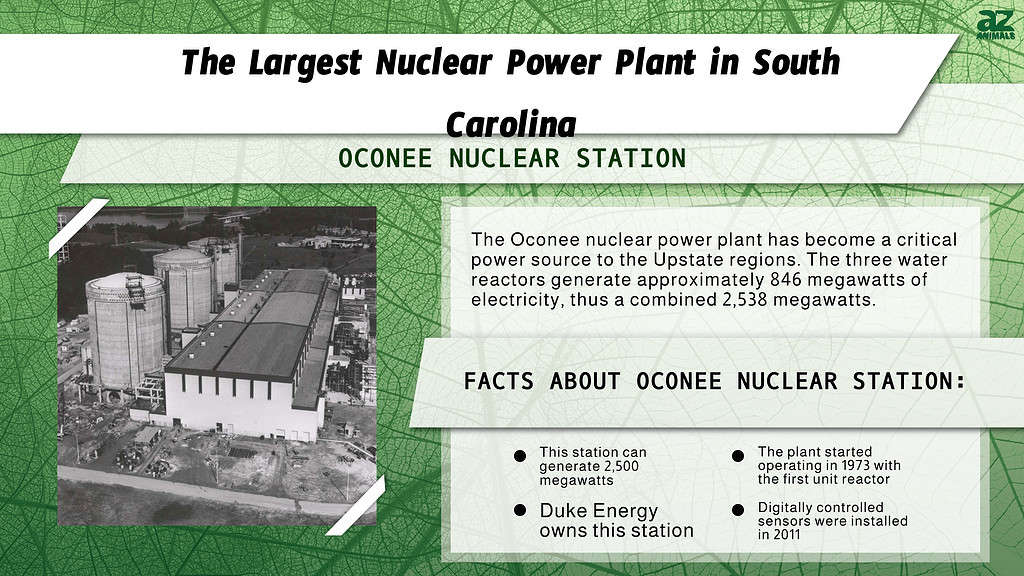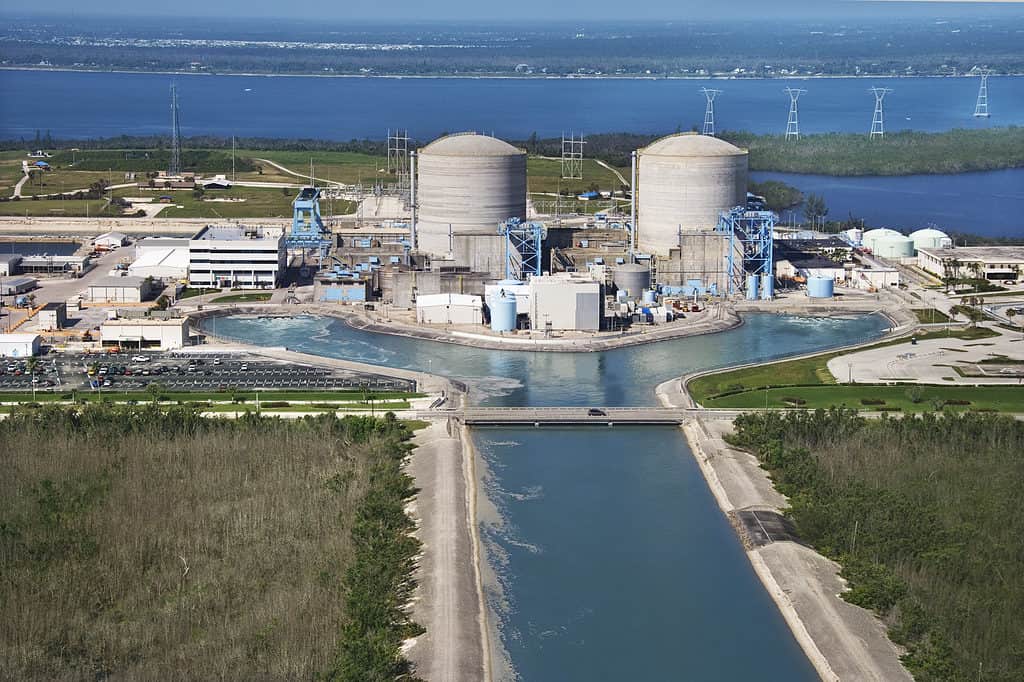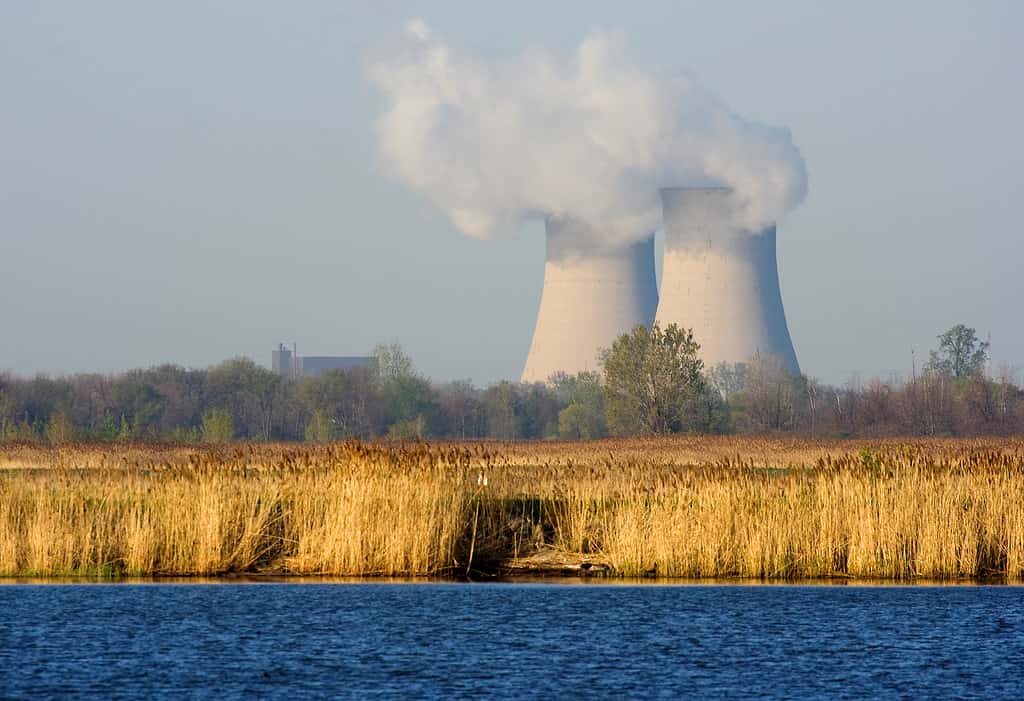South Carolina’s largest nuclear power plant has a public perception that’s a mix of positive and negative. Nuclear power plants are reliable and efficient energy sources, reducing dependence on fossil fuels and mitigating climate change. The potential to generate large amounts of electricity without greenhouse gas emissions is an environmentalist dream solution for pollution.
Unfortunately, there have been tragic incidents associated with nuclear power plants that had devastating impacts on human health, life, and the environment. One of the most infamous disasters was the 1986 Chernobyl nuclear plant explosion that released radioactive material into the atmosphere and resulted in multiple deaths as well as widespread environmental damage.
Fortunately, South Carolina’s largest nuclear power plant hasn’t experienced a similar tragedy. Discover what lives around it and how its presence affects the local area.

South Carolina’s Largest Nuclear Plant
South Carolina has four nuclear power stations and one electric generating plant. These are:
- Catawba Nuclear Station
- Robinson Nuclear Plant
- Oconee Nuclear Station
- V.C. Summer Nuclear Station
- Vogtle Electric Generating Plant
Oconee nuclear station can generate 2,500 megawatts. These come from the three pressurized water reactors within the nuclear plant.
Oconee nuclear station is the property of Duke Energy. The plant started operating in 1973 with the first unit reactor. The Unit 2 and 3 reactors joined the process in 1974. Duke Energy responded to the growing demand for electricity within the region, thus establishing the plant.
Duke Energy positions itself as the first company to produce more than 500 million megawatts of electricity from this particular power plant. The record is unmatched by any other in the United States.
Another first for the company is that in 2011, the Oconee Nuclear Power Station installed digitally controlled sensors, which allows for advanced monitoring resulting in higher accuracy and more reliable measurements of critical parameters like pressure, temperature, and radiation levels.
Also, digital control systems allow for real-time monitoring, significantly impacting how fast teams can respond to anomalies. An example would be detecting extremely high radiation levels in a specific area. The control system automatically triggers alarms to initiate safety protocols, thus protecting workers and the surrounding environments.
The accolades don’t end there. A third feather in Duke Energy’s cap is that the Oconee power plant has the unique distinction of zero reliance on emergency diesel generators. Instead, it uses two hydroelectric units located in the nearby Keowee hydroelectric station.
As an additional power backup, the company has tapped into the nearby Lee Fossils generating station that uses combustion turbines. Alternative cables independent of the Oconee transmission lines and switchyard route the power to the nuclear plant emergency systems.
The Oconee nuclear power plant has become a critical power source to the Upstate regions. The three water reactors generate approximately 846 megawatts of electricity, thus a combined 2,538 megawatts.

The Oconee nuclear power plant provides clean energy to the surrounding area while taking safety and security precautions to ensure the safety of workers and the environment.
Reported Incidents at Oconee Nuclear Station
There have been a few reported incidents at Oconee nuclear power station. Fortunately, none had the level of devastation associated with the larger nuclear plant accidents. The most notable are:
- 1982 failure of the feedwater heat extraction line.
- A 1991 unit 1 cooler failure and over-pressurizing of the piping systems. Quick action by the plant operators led to the shutting down of the reactor and the undertaking of urgent valve repair work. There were no injuries or release of any radioactive material.
- A 1995 unit 2 fire on an electrical panel. Once again, plant operators came to the rescue and put out the fire.
- 1996 burst pipeline resulting in severe burn injuries on seven workers. No radiation leakage was reported.
- A 2012 Transformer failure resulted in the automatic shutdown of reactors. Duke Energy replaced the transformer services and resumed without any further incidents.
- A 2016 fire incident at the plant damaged a switchyard power line. Fortunately, the switchyard isn’t in one area with the generators, reactors, or turbines. Thus, there was no release of radioactive material.
- A 2022 report of unusual events at the Unit 2 reactor. Reports show that steam melted off some of the paint on the pipes creating smoke. The smoke set off alarms, but fortunately, there was no fire.
Where is Oconee Nuclear Power Station Located on a Map?
The Oconee Nuclear Station is located on Lake Keowee, on the Rochester Highway (SC-183), near Seneca, and 30 miles W of Greenville, South Carolina. Clemson University is just 23 minutes away (13.2 miles)
Dispelling Common Myths Around Nuclear Power Plants
As we stated in our introduction, some parties view nuclear power plants negatively. Most of their perception gains traction due to common misleading myths around such installations. Let’s look at some common ones and shed a little light that will dispel such notions.
Nuclear Power Plants Are Not Safe
A look at the devastating impacts of accidents around nuclear power plants gives potency to this safety myth. Yet understanding the installation and multiple safety features will show you otherwise. Plenty of time and resources go into building nuclear power plants. They have numerous components and redundancy systems to prevent the occurrence of accidents. We concur with industry experts who believe that ensuring safety is a critical part of every nuclear plant.
The redundant backup systems kick into action when the reactor overheats by automatically shutting it down. Multiple backup power sources and critical systems continue to operate, even during power disruption.
Duke Energy has also invested in a robotic dog to help with safety inspections. The robot can access hard-to-reach areas like underground piping. The real-time feedback from the camera on the robot and 5G connectivity allow for live streaming. Collision avoidance capabilities enable it to circumnavigate obstacles and more.
America has an excellent track record of having the most secure nuclear facilities. But it goes beyond industry players like Duke Energy postulating about the measures they have implemented. Industrial regulatory authorities are on their tails to ensure compliance at all times. The Nuclear Regulatory Commission (NRC) was in the US in 1974. Its role is to provide the safe use of radioactive material for the benefit of civilians while protecting them and the environment.
The NRC must approve every aspect of nuclear power operations, designs, maintenance, and waste handling. The energy company must also prove its emergency preparedness and response and personnel training for everyone working in the plant.

Nuclear energy has an incredibly low rate of negative impacts on the environment – making it one of our most sustainable energy sources.
©iStock.com/iofoto
Nuclear Power Plants Generate a Lot of Waste
It would be misleading to say that nuclear power plants don’t produce radioactive waste. Indeed that is one of the byproducts of nuclear energy production. The waste comes in the form of contaminated material, spent fuel rods containing high levels of radioactive material, and other waste.
But, if you compare it to other types of power generation, the amount is less. For example, if you compare what comes out of a nuclear power plant as waste versus that of a coal-fired power plant, there is more to deal with in the latter. The type of waste includes soot, ash, and other pollutants.
The regulators also require companies that run nuclear power plants to have proper waste disposal and handling measures in place. These are usually heavily fortified containers at the site for cooling and safety monitoring of the waste.
Nuclear Power Plants Pollute the Environment
Many environmentalists are concerned about climate change and its impact on animals and humans. Greenhouse emissions and human activities have mainly contributed to shifts in global weather patterns.
For instance, burning fuel to produce coal, gas, and oil is a major pollutant contributing to greenhouse emissions. The gasses trap heat, causing a warming of the earth. Some reports show that animals like polar bears could lose their natural habitats due to ice melting in the Arctic regions. The same applies to other animals like the Arctic fox, walruses, and moose.
Nuclear power may be part of the solutions to the devastating climate change impacts of power generation. The process does not result in the emission of greenhouse gasses or other pollutants. Nuclear energy is, therefore, cleaner compared to fossil fuels.
Nuclear fission results in electricity generation by splitting uranium atoms and other radioactive materials; the splitting results in the release of vast energy amounts in the form of heat. The heat generates steam which powers turbines to produce electricity.
Nuclear Power Plants are Expensive
Undoubtedly the initial cost of installing any electricity-producing plant would be high. And the same applies to a nuclear power plant. But, if you look at the long-term implications, the operating costs tend to be lower. Take the example of fuel costs associated with running a nuclear power plant. Uranium, the primary fuel, is less expensive than the recurring cost of purchasing natural coal or gas. With the latter, there’s also the aspect of supply disruptions and price fluctuations.
Nuclear Power Plants and Radiation Exposure Go Hand-in-Hand
The doomsayers will push the narrative about radiation exposure going hand-in-hand with nuclear power plants. And Hollywood has managed to paint a pretty grim picture of a post-apocalyptic world. Movies like Chernobyl Diaries, The Day After, and even the 1979 movie Mad Max fill people with dread.
Let go of that notion today because there have been no health effects related to radiation leaks from nuclear power plants in decades. We reiterate that the industry is under constant and stringent regulation by the NRC.
The facility designs also consider direct radiation and containment within the relevant structures. You are more at risk of radiation effects from an X-ray than if you stood outside Oconee for a year. Radiation from the plant would be about one millirem compared to the X-ray’s four millirems. The radiation from the home construction material is way higher.

Despite common misconceptions, nuclear power and radiation do not go hand-in-hand.
©James Marvin Phelps/Shutterstock.com
Plant, Animal, and Human Life Around Oconee Nuclear Power Plant
If you haven’t been to or near the Oconee nuclear power plant, don’t expect to see zombies, sparse vegetation, and animal skeletons lying around. You won’t even see the same if you were to visit Chernobyl.
Reports show that even the Chernobyl exclusion zone, set up after the disaster, is beginning to see plant and animal life. That shows the resilience of these species to nuclear disasters. Bears, boars, and wolves are returning to the lush forests around the plant.
As discussed earlier, highly regulated nuclear plants hardly contribute to pollution or greenhouse emissions. Instead, what you see is a scenic area comprising farmlands and forests. Within are diverse species of animals and plant life. Also, the Oconee Nuclear Station has over 800 employees, making it a significant regional employer.
The nuclear plant is based in a forested area, meaning there is an abundance of fauna and flora.
Plant Life
Common plant species include:
- Pine the predominant tree featuring different species, such as longleaf, slash pine, and loblolly.
- Hardwood trees such as oak, maple, and hickory.
- Wildflowers bloom in spring and summer, bringing brilliance and beauty. Common types include goldenrod, butterfly weed, and black-eyed Susan.
- Grass species like bluestem and switchgrass.
- Shrubs like mountain laurel, blueberry, and blackberry.
Animal Life
A wide range of animal species inhabits the area around the Oconee Nuclear power plant, as follows.
- Birds such as hawks, owls, songbirds, and woodpeckers
- Mammals like coyotes, foxes, squirrels, white-tailed deer, and raccoons
- Reptiles such as lizards, turtles, and snakes
- Amphibians like toads, frogs, and salamanders
According to Duke Energy, the area around nuclear plants is ideal for wildlife and plants as a result of:
- Large tracts of undisturbed land mean minimal disturbance to wildlife that have made the area home.
- Low levels of human activity due to the remote location of most nuclear plants result in a peaceful and quiet environment that wildlife needs to thrive.
- Continuous and enhanced monitoring of nuclear power plants due to the strict regulations by regulatory bodies helps ensure a safe and healthy environment for humans, plants, and animals.
Nuclear power-producing companies undertake habitat enhancement programs to improve the environment. The focus is on protecting and enhancing the fauna and flora within the surrounding areas.
The Keowee-Toxaway Enhancement Program
Duke Energy is an advocate of protecting the environment. It has partnered with the South Carolina Department of Natural Resources to develop The Keowee-Toxaway Enhancement program. The program aims to enhance and preserve natural habitats and wildlife populations within the Keowee-Toxaway watershed. And that includes the Oconee nuclear station. These are some of the habitat enhancement and restoration projects done by the Keowee-Toxaway Enhancement Program:
- Planting of native vegetation
- Creating wildlife habitats
- Restoring streams and wetlands
All these efforts go toward improving the quality of the citizens’ lives by increasing biodiversity to support healthy plants, wildlife, and fish. The steps by Duke Energy are worth applauding. When undertaken by nuclear power operators, such initiatives can contribute to ensuring a sustainable environment for future generations.

From coyotes and birds to turtles and fish, there’s plenty of life in this nature-filled area.
©seo byeong gon/Shutterstock.com
Oconee Nuclear Power Plant; South Carolina’s Largest
Oconee Nuclear power plant is a critical power source for Duke Energy customers. Nuclear power has much to offer, including being a clean energy source that doesn’t add to environmental pollution. This is a critical factor in plant and animal life around such power plants.
Fortunately, the biodiversity around Oconee, the largest South Carolina power plant, is thriving. There are initiatives by the company and other partners to ensure sustainability for the enjoyment of future generations.
The photo featured at the top of this post is © iStock.com/ake1150sb
Thank you for reading! Have some feedback for us? Contact the AZ Animals editorial team.






